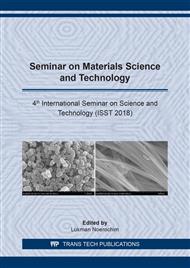p.115
p.124
p.130
p.136
p.145
p.151
p.156
p.161
p.168
The Effect of Mixed Culture of Zymomonas mobilis and Pichia stipitis in Ethanol Production of Sugar Palm (Arenga pinnata)
Abstract:
In this study the effect of mixed culture of Zymomonas mobilis and Pichia stipitis to produce bioethanol from Solid Waste Arenga pinnata (SWAP) was investigated. The fermentation liquid substrate was resulted from an integrated process of pretreatment and enzymatic hydrolysis. Combination of diluted acid and ethanol organosolv pretreatment was used to increase the SWAP lignin removal. Raw pretreatment was used to decrease the SWAP particle size to 200 mesh. Acid pretreatment was done using 5% (v/v) diluted sulfate acid. Acid pretreated SWAP was treated for 65 min with organosolv pretreatment. Enzymatic hydrolysis by a combination of cellulase and xylanase was done for 48 h to convert cellulose into reducing sugar. The surfactants (Tween 80) addition was done to increase the sugar yield of the hydrolysis process. Fermentation variable consist of single culture of Z. mobilis as the control and mixed culture of Z. mobilis and P. stipitis, the microorganisms used to convert glucose and xylose into ethanol. The number of inoculum used in this experiment was more than 1.4 billion cells and the duration of fermentation process was 72 h. The delignification process decreased 95.43% lignin in SWAP. X-ray Diffraction (XRD) analysis assay showed an increase of crystallinity index of SWAP with pretreatment combination to 37.87%. Enzymatic hydrolysis by a combination of cellulase and xylanase with the addition of Tween 80 produced 9.16 gr glucose/L reducing sugar concentration. The highest ethanol resulted by fermentation process using mixed culture of Z. mobilis and P. stipitis with 0.33% (v/v) ethanol concentration and 0.57 (g ethanol/g reducing sugar) ethanol yield. Fermentation process using single culture Z. mobilis resulted 0.28% (v/v) ethanol concentration, and 0.48 (g ethanol/g reducing sugar) ethanol yield. The mixed culture fermentation with Z. mobilis and P. stipitis resulted ethanol yield 19 % higher than the single culture fermentation using Z. mobilis.
Info:
Periodical:
Pages:
145-150
Citation:
Online since:
July 2019
Price:
Сopyright:
© 2019 Trans Tech Publications Ltd. All Rights Reserved
Share:
Citation:



